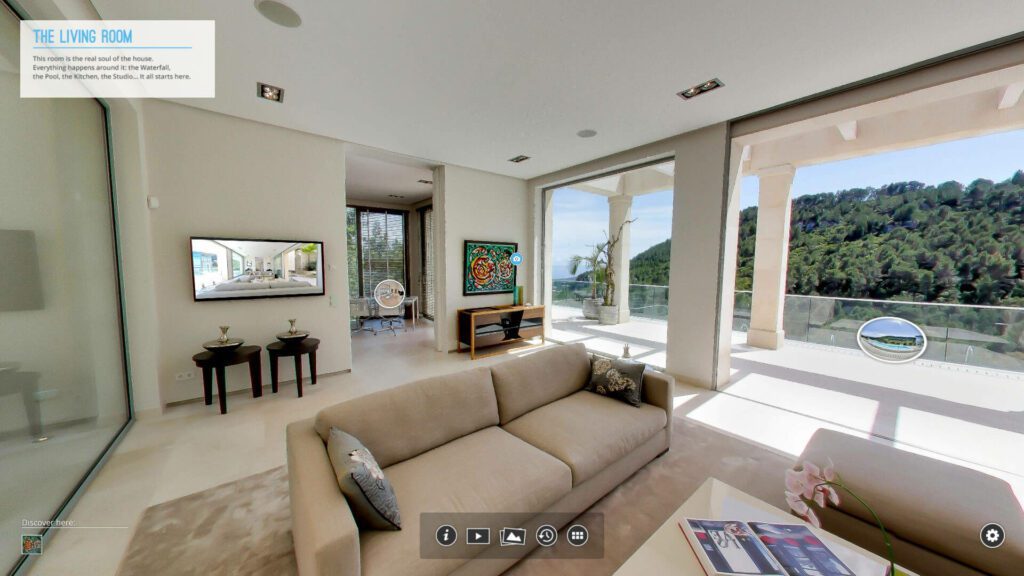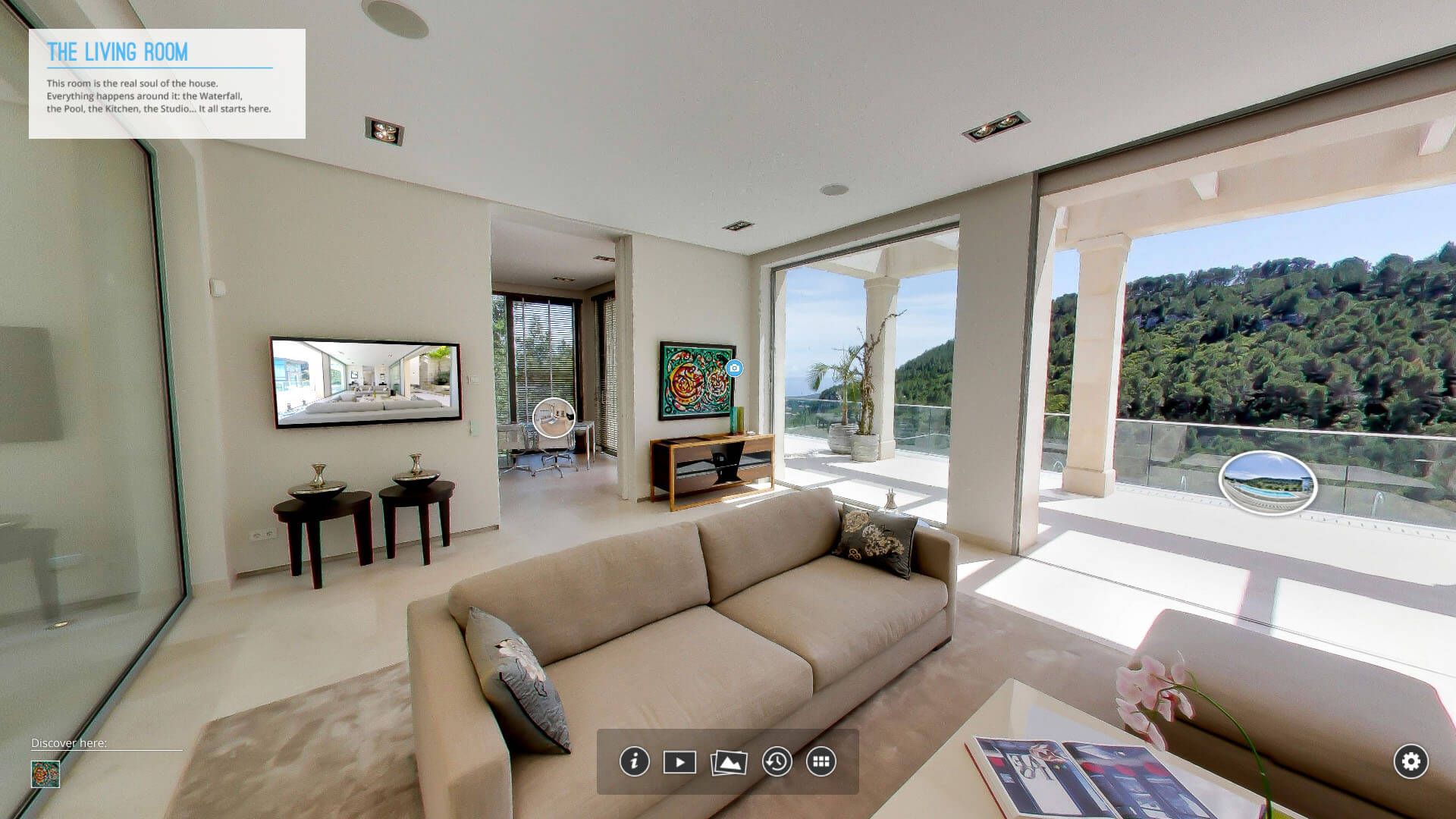In the highly competitive real estate market, standing out and capturing the attention of potential buyers is crucial. Traditional methods of showcasing properties, such as in-person tours and static photos, are no longer sufficient to meet the demands of today’s tech-savvy consumers. Enter virtual tours—a game-changing tool that is revolutionizing real estate marketing. This article delves into how virtual tours are transforming the way properties are marketed and sold, the benefits they offer to both buyers and sellers, and why they have become an indispensable asset in the digital age.


What are Virtual Tours?
Virtual tours are immersive, 360-degree visual experiences that allow potential buyers to explore properties from the comfort of their homes. Unlike traditional photos or videos, virtual tours provide an interactive experience where users can navigate through a property as if they were physically there. This technology leverages high-quality panoramic images or videos stitched together to create a seamless and realistic representation of a space.
Virtual tours can be accessed via computers, smartphones, or VR headsets, making them highly accessible and user-friendly. They have become a powerful marketing tool, especially in the real estate industry, where visualizing a space is critical for making informed decisions.
The Benefits of Virtual Tours for Real Estate Marketing
- Enhanced Property Showcase
- Immersive Experience: Virtual tours offer a fully immersive experience that allows potential buyers to explore every corner of a property. They can move from room to room, zoom in on details, and get a true sense of the property’s layout and flow. This level of engagement is far superior to static images and gives buyers a deeper connection to the property.
- True Representation of Space: One of the challenges with traditional photos is that they can sometimes be misleading or fail to capture the true essence of a space. Virtual tours provide a more accurate representation of a property, allowing buyers to experience the space as if they were walking through it in person. This transparency builds trust and can lead to quicker and more confident purchasing decisions.
- Broader Reach and Accessibility
- Global Audience: Virtual tours break down geographical barriers, enabling potential buyers from around the world to view properties without having to travel. This is particularly beneficial for international buyers or those relocating from other cities. By offering virtual tours, real estate agents can tap into a global market and attract a wider audience.
- 24/7 Availability: Unlike traditional open houses or in-person tours, virtual tours are available 24/7. This means that potential buyers can view properties at their convenience, whether it’s late at night or during a lunch break. This flexibility increases the chances of attracting serious buyers who might otherwise be unable to attend a physical tour.
- Time and Cost Efficiency
- Streamlined Process: Virtual tours save time for both real estate agents and buyers. Agents no longer need to schedule multiple in-person viewings, and buyers can quickly narrow down their options by virtually touring properties before deciding to visit in person. This streamlined process makes the buying journey more efficient and less stressful.
- Cost-Effective Marketing: Creating virtual tours may require an initial investment, but the long-term benefits far outweigh the costs. Virtual tours can be reused for marketing purposes across multiple platforms, including websites, social media, and listing portals. This versatility makes them a cost-effective tool for real estate marketing.
- Higher Engagement and Conversion Rates
- Interactive Content: Virtual tours are inherently more engaging than traditional photos or videos. The interactive nature of these tours keeps potential buyers on a listing for longer periods, increasing the likelihood of them taking the next step, whether it’s scheduling an in-person visit or making an offer. Studies have shown that listings with virtual tours receive more inquiries and higher levels of interest.
- Increased Trust and Confidence: Virtual tours provide a level of transparency that can build trust with potential buyers. When buyers feel confident that they have a clear understanding of a property, they are more likely to make a decision. This increased confidence can lead to faster sales and a higher conversion rate for real estate agents.
- Competitive Advantage
- Stand Out in the Market: In a crowded real estate market, offering virtual tours can give agents and sellers a competitive edge. Properties with virtual tours tend to stand out in listings and attract more attention from potential buyers. This differentiation can be the key to selling a property faster and at a higher price.
- Modern Marketing Strategy: As the real estate industry continues to evolve, adopting modern marketing strategies like virtual tours is essential for staying relevant. Buyers today expect a seamless, tech-driven experience, and agents who offer virtual tours demonstrate that they are in tune with current trends and consumer expectations.
Applications of Virtual Tours in Real Estate
- Residential Real Estate
- Home Showcases: Virtual tours are ideal for showcasing residential properties, from single-family homes to luxury apartments. They allow potential buyers to explore a home’s layout, visualize how their furniture might fit, and get a feel for the neighborhood—all from their computer or mobile device.
- Pre-Sales for New Developments: For new developments that are still under construction, virtual tours can provide potential buyers with a preview of what the finished property will look like. This is particularly useful for pre-sales, where buyers need to make decisions based on plans and renderings.
- Commercial Real Estate
- Office Spaces and Retail Locations: Virtual tours are also valuable in commercial real estate, where potential tenants or buyers need to assess spaces like office buildings, retail locations, or industrial properties. Virtual tours can showcase the layout, size, and amenities of commercial properties, making it easier for businesses to find the perfect location.
- Investment Properties: Investors looking to purchase rental properties or commercial spaces can use virtual tours to evaluate multiple options quickly. This allows them to make informed decisions without the need to travel to each property in person, saving time and resources.
- Luxury Real Estate
- High-End Showcases: Luxury real estate often involves high-value properties that require a unique marketing approach. Virtual tours provide an immersive experience that highlights the luxurious features and details of these properties, attracting discerning buyers who may be considering properties in multiple locations around the world.
The Future of Virtual Tours in Real Estate
The future of virtual tours in real estate is bright, with continuous advancements in technology making these experiences even more immersive and accessible. Here are some trends to watch:
- Integration with Virtual Reality (VR)
- Full Immersion: As VR technology becomes more mainstream, virtual tours will become even more immersive, allowing potential buyers to experience properties in a fully simulated environment. With VR headsets, users can “walk” through properties, interact with features, and get a true sense of scale and space.
- Enhanced Data and Analytics
- Buyer Insights: Virtual tours can be integrated with data analytics tools to provide real estate agents with valuable insights into buyer behavior. By tracking how users interact with a virtual tour, agents can gain a better understanding of what features or spaces are most appealing to potential buyers, allowing them to tailor their marketing strategies accordingly.
- Augmented Reality (AR) Features
- Customizable Experiences: AR technology can be combined with virtual tours to offer customizable experiences. For example, buyers could use AR to visualize how different furniture or design elements would look in a space, allowing for a more personalized and interactive experience.
- Sustainability in Real Estate Marketing
- Reducing Carbon Footprint: As sustainability becomes increasingly important, virtual tours offer a way to reduce the carbon footprint associated with real estate marketing. By minimizing the need for in-person visits, virtual tours can contribute to more environmentally friendly practices in the industry.
Conclusion
Virtual tours have become an essential tool for real estate marketing in the digital age, offering a range of benefits for both buyers and sellers. From providing an immersive and interactive experience to reaching a global audience, virtual tours are transforming the way properties are showcased and sold. As technology continues to evolve, the role of virtual tours in real estate will only become more prominent, making them a must-have for any modern real estate marketing strategy. For real estate agents and sellers looking to stay ahead of the curve, investing in virtual tours is not just an option—it’s a necessity.


